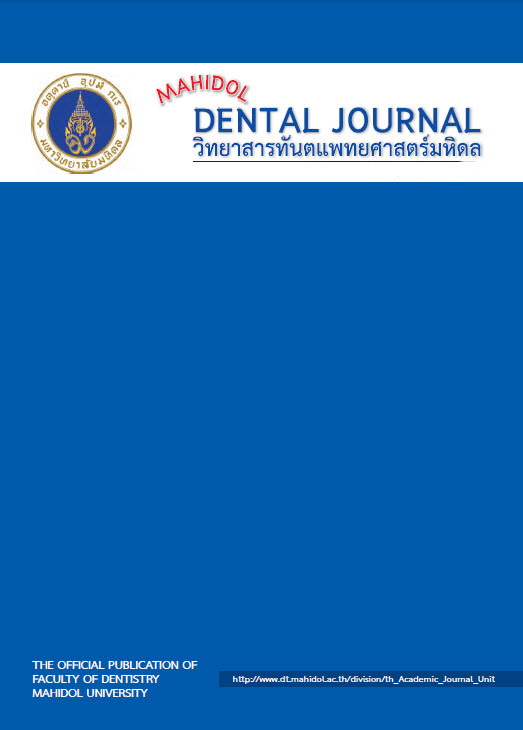Fracture mechanics approach to determine bonding quality of two ceramics
Main Article Content
Abstract
Objective: To evaluate bonding quality of bilayered and monolithic dental ceramics using chevron-notch specimens.
Materials and methods: The monolithic blocks of ceramic core materials (IPSe.max®Press) and ceramic veneering material (IPSe.max®Ceram) were fabricated. In addition, the blocks of bilayered ceramic (IPS e.max®Press/ IPSe.max®Ceram) was also fabricated. The triangular notch shape were created at the middle of the prepared bars and at the interface between two ceramics (3x4x16 mm) by using the specific devices and loaded in tension until failure. Optical microscope and Scanning Electron Microscope (SEM) were used to determine the crack propagation and ensure the mode of failure. Then, the bonding quality of the bilayered and monolithic specimens were analyzed.
Results: All of the specimen failures were found at the interface. The optical microscope revealed that the crack was initiated at the tip of the triangular notch and the failure occurred along the interface. Accordingly, the interfacial failure pattern was classified.
Conclusions: The test reveals the different approach to evaluate the bonding effectiveness of the ceramics. Specimen size and cutting angle of the triangular notch can be control. The sample can be readily prepared. Therefore, this test can be used as a valid alternative to analysed the bonding quality of the ceramics because the approach ensured the interfacial failure.
Article Details
References
2. De Backer H, Van MG, De Moor N, Van den Berghe L, De Boever J. A 20-year retrospective survival study of fixed partial dentures. Int J Prosthodontics 2006; 19: 143-53.
3. Guazzato M, Proos K, Quach L, Swain MV. Strength, reliability and mode of fracture of bilayered porcelain/zirconia (Y-TZP) dental ceramics. Biomaterials 2004; 25: 5045-52.
4. Guazzato M, Proos K, Sara G, Swain MV. Strength, reliability, and mode of fracture of bilayered porcelain/core ceramics. Int J prosthodontics 2004; 17: 142-9.
5. Conrad HJ, Seong WJ, Pesun IJ. Current ceramic materials and systems with clinical recommendations: a systematic review. J Prosthet Dent 2007 ; 98: 389-404.
6. Belli R, Frankenberger R, Appelt A, Schmitt J, Baratieri LN, Greil P, et al. Thermal-induced residual stresses affect the lifetime of zirconia-veneer crowns. Dent Mater 2013; 29: 181-90.
7. Taskonak B, Mecholsky JJ, Anusavice KJ. Residual stresses in bilayer dental ceramics. Biomaterials 2005; 26: 3235-41.
8. Wendler M, Belli R, Petschelt A, Lohbauer U. Characterization of residual stresses in zirconia veneered bilayers assessed via sharp and blunt indentation. Dent Mater 2015; 31: 948-57.
9. DeHoff PH, Barrett AA, Lee RB, Anusavice KJ. Thermal compatibility of dental ceramic systems using cylindrical and spherical geometries. Dent Mater 2008; 24: 744-52.
10. Mainjot AK, Najjar A, Jakubowicz-Kohen BD, Sadoun MJ. Influence of thermal expansion mismatch on residual stress profile in veneering ceramic layered on zirconia: Measurement by hole-drilling. Dent Mater 2015; 31: 1142-9.
11. Aboushelib MN, De Jager N, Kleverlaan CJ, Feilzer AJ. Microtensile bond strength of different components of core veneered all-ceramic restorations. Dent Mater 2005; 21: 984-91.
12. Anunmana C, Champirat T, Jirajariyavej B. Tensile strength of bilayered ceramics and corresponding glass veneers. J Adv Prosthodont 2014; 6: 151-6.
13. Soderholm KJ. Review of the fracture toughness approach. Dent Mater 2010; 26: 63-77.
14. Della BA, Van NR. Shear vs tensile bond strength of resin composite bonded to ceramic. J Dent Res 1995; 74: 1591-6.
15. El Zohairy AA, De Gee AJ, de Jager N, van Ruijven LJ, Feilzer AJ. The influence of specimen attachment and dimension on microtensile strength. J Dent Res 2004; 83: 420-4.
16. Goracci C, Sadek FT, Monticelli F, Cardoso PE, Ferrari M. Influence of substrate, shape, and thickness on microtensile specimens' structural integrity and their measured bond strengths. Dent Mater 2004; 20: 643-54.
17. Van NR, Noroozi S, Howard IC, Cardew G. A critique of bond strength measurements. J Dent 1989; 17: 61-7.
18. Barker LM. a simplified method for measuring plane strain fracture toughness. Eng Fract Mech 1977; 1.4
19. Tam LE, Pilliar RM. Fracture toughness of dentin/resin-composite adhesive interfaces. J Dent Res 1993; 72: 953-9.
20. Anunmana C, Anusavice KJ, Mecholsky JJ, Jr. Interfacial toughness of bilayer dental ceramics based on a short-bar, chevron-notch test. Dent Mater 2010; 26: 111-7.
21. Boccaccini AR, Rawlings RD, Dlouhý I. Reliability of the chevron-notch technique for fracture toughness determination in glass. Mater. Sci. Eng 2003; 347: 102-8.
22. Kailer A, Stephan M. On the feasibility of the Chevron Notch Beam method to measure fracture toughness of fine-grained zirconia ceramics. Dent Mater 2016; 32: 1256-62.
23. Bubsey RT, Munz D, Pierce WS, Shannon JL, Jr. Compliance calibration of the short rod chevron-notch specimen for fracture toughness testing of brittle materials. Int J Fract 1982; 18: 125-33.
24. Phrukkanon S, Burrow MF, Tyas MJ. The influence of cross-sectional shape and surface area on the microtensile bond test. Dent Mater 1998; 14: 212-21.
25. Pongprueksa P, De Munck J, Barreto BC, Karunratanakul K, Van MB. Mini-interfacial fracture toughness as a new validated enamel-bonding effectiveness test. J Mech Behav Biomed Mater 2016; 62: 446-55.
26. Pongprueksa P, De Munck J, Karunratanakul K, Barreto BC, Van EA, Senawongse P, et al. Dentin Bonding Testing Using a Mini-interfacial Fracture Toughness Approach. J Dent Res 2016; 95: 327-33.
27. Freifrau VMN, Kleibe M, Stiesch M, Hubsch C, Kohorst P. Interfacial adhesion of zirconia/veneer bilayers with different thermal characteristics. Dent Mater J 2014; 33: 583-90.


